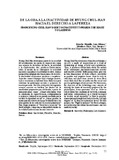| dc.rights.license | http://creativecommons.org/licenses/by-nc-sa/3.0/ve/ | es_VE |
| dc.contributor.author | Briceño-Montilla, Luis Alfonso | |
| dc.contributor.author | Mendoza-Pérez, Luz Omaira | |
| dc.date.accessioned | 2023-06-16T13:20:38Z | |
| dc.date.available | 2023-06-16T13:20:38Z | |
| dc.date.issued | 2023-06-16 | |
| dc.identifier.issn | 0798-1570 | |
| dc.identifier.uri | http://www.saber.ula.ve/handle/123456789/49552 | |
| dc.description.abstract | Byung Chul Han determina a partir de la sociedad del rendimiento un modo de imposición
como una especie de dictadura del hacer, la actividad y la explotación. Así, produce
distinciones sobre la noción de su contraparte la actividad
mecánica-maquinal y la actividad creativa. Ambas perspectivas originan dos dimensiones
de su revés, la inactividad en términos positivos y negativos. Aspectos como el tiempo
vital y tiempo muerto, tejen o tensionan su habitual línea dialéctica para sintetizar
las patologías sociales y psíquicas de nuestro presente. Por ello, el objetivo del
siguiente ensayo consiste en bordear los límites de la inactividad propuestos por el
filósofo; a partir de interpelaciones como: ¿Cómo refl exionar bajo la condición de
supervivencia, codependencia económica y laboral en un mundo asediado por la terrible
desigualdad social? o ¿Cómo generar la emancipación a través de la inactividad frente
a los altos grados de la caída del IQ a nivel planetario? Para luego propone el
“Derecho a la pereza” de Paul Lafargue, como una acción política dentro de la realidad
material mucho más concreta. | es_VE |
| dc.language.iso | es | es_VE |
| dc.publisher | SaberULA | es_VE |
| dc.rights | info:eu-repo/semantics/openAccess | es_VE |
| dc.subject | Inactividad | es_VE |
| dc.subject | Filosofía | es_VE |
| dc.subject | Derecho | es_VE |
| dc.subject | Pereza | es_VE |
| dc.title | De la oda a la inactividad de Byung Chul-han hacia el derecho a la pereza | es_VE |
| dc.title.alternative | From Byung Chul-han’s ode to inactivity towards the right to laziness | es_VE |
| dc.type | info:eu-repo/semantics/article | es_VE |
| dcterms.dateAccepted | Noviembre-2022 | |
| dcterms.dateSubmitted | Septiembre-2022 | |
| dc.description.abstract1 | Byung Chul Han determines from the performance society a mode of imposition as a kind
of dictatorship of doing, activity and exploitation. Thus, it produces distinctions
about the notion of its counterpart, mechanical-machine activity
and creative activity. Both perspectives give rise to two dimensions of their setback,
inactivity in positive and negative terms. Aspects such as vital time and dead time,
weave or stress their usual dialectical line to synthesize the social and psychic
pathologies of our present. For this reason, the objective of the following essay
consists of skirting the limits of inactivity proposed by the philosopher; from
questions such as: How to reflect under the condition of survival, economic and labor
codependency in a world besieged by terrible social inequality? o How to generate
emancipation through inactivity in the face of high degrees of IQ drop at a planetary
level? To then
propose the “Right to laziness” by Paul Lafargue,as a political action within the much
more concrete material reality. | es_VE |
| dc.description.colacion | 75-82 | es_VE |
| dc.description.email | ciudadbohemia1@gmail.com | es_VE |
| dc.description.email | luzomaira_19@hotmail.com | es_VE |
| dc.description.frecuencia | Semestral | |
| dc.description.paginaweb | http://www.saber.ula.ve/cifranueva/ | |
| dc.identifier.depositolegal | P P92-0047 | |
| dc.identifier.edepositolegal | ppi 201202ME4019 | |
| dc.identifier.eissn | 2244-8438 | |
| dc.publisher.pais | Venezuela | es_VE |
| dc.subject.institucion | Universidad de Los Andes | es_VE |
| dc.subject.keywords | Inactivity | es_VE |
| dc.subject.keywords | Philosophy | es_VE |
| dc.subject.keywords | Law | es_VE |
| dc.subject.keywords | Laziness | es_VE |
| dc.subject.seccion | Revista Cifra Nueva: Artículos | es_VE |
| dc.subject.tipo | Artículos | es_VE |
| dc.type.media | Texto | es_VE |
| dc.contributor.orcid | http://orcid.org/0000-0001-6713-1070 | |


